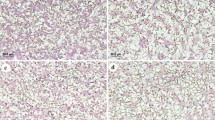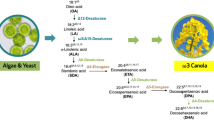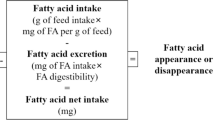Abstract
Rapid expansion of aquacultural production is placing increasing demand on fish oil supplies and intensified the search for alternative lipid sources. Many of the potential alternative sources contain low concentrations of long chain n-3 fatty acids and the conversion of dietary linolenic acid to longer chain highly unsaturated fatty acids is a relatively inefficient process in some species. A 6-week study was conducted to compare tissue fatty acid (FA) concentrations in hybrid striped bass fed either 18:3n-3 (α-linolenic acid; ALA) or 18:4n-3 (stearidonic acid; SDA). Hybrid striped bass were fed either a control diet containing fish oil, or diets containing ALA or SDA at three different levels (0.5, 1 and 2% of the diet). There were no significant differences in whole animal responses between fish fed ALA or SDA. Liver and muscle concentrations of ALA and SDA were responsive to dosages fed. However, only 22:6n-3 concentrations in muscle were significantly affected by dietary source of 18 carbon precursors. Muscle 22:6n-3 concentrations were significantly higher in fish fed SDA compared to fish fed ALA. Based on these data, it appears that feeding SDA can increase long chain n-3 fatty acid concentrations in fish muscle.
Similar content being viewed by others
Abbreviations
- ALA:
-
Linolenic acid
- ANOVA:
-
Analysis of variance
- AA:
-
Arachidonic acid
- DHA:
-
Docosahexaenoic acid
- DPA:
-
Docosapentaenoic acid
- EPA:
-
Eicosapentaenoic acid
- EFA:
-
Essential fatty acid
- FAME:
-
Fatty acid methyl esters
- FA:
-
Fatty acid
- FID:
-
Flame ionization detector
- GC:
-
Gas chromatograph
- HUFA:
-
Highly unsaturated fatty acid
- IPF:
-
Intraperitoneal fat
- LC-n-3 HUFA:
-
Long chain n-3 highly unsaturated fatty acids
- MONO:
-
Total monounsaturated fatty acids
- PSEM:
-
Pooled standard error of the mean
- RLW:
-
Relative liver weight
- SAT:
-
Total saturated fatty acid
- SDA:
-
Stearidonic acid
References
New MB, Wijkstroem UN (2002) Use of fishmeal and fish oil in aquafeeds: further thoughts on the fishmeal trap. FAO circular no. 975. Food and Agriculture Organization of the United Nations Rome
Rosenlund G, Obach A, Sandberg MG, Standal H, Tveit K (2001) Effect of alternative lipid sources on long-term growth performance and quality of Atlantic salmon (Salmo salar L.). Aquacult Res 32:323–328
Torstentsen BE, Bell JG, Rosenlund G, Henderson RJ, Graff IE, Tocher DR, Lie Ø, Sargent JR (2005) Tailoring of Atlantic salmon (Salmo salar L.) flesh lipid composition and sensory quality by replacing fish oil with a vegetable oil blend. J Agric Food Chem 53:10166–10178
NRC (1998) Nutrient requirements of swine. National Academy Press, Washington
Turchini GM, Torstensen BE, Ng WK (2009) Fish oil replacement in finfish nutrition. Rev Aquacult 1:10–57
Sargent JR, Bell JG, Bell MV, Henderson RJ, Tocher DR (1995) Requirement criteria for essential fatty acids. J Appl Ichthyol 11: 183–198
Takeuchi T (1997) Essential fatty acid requirements of aquatic animals with emphasis on fish larvae and fingerlings. Rev Fish Sci 5:1–25
Sargent JR, Tocher DR, Bell JG (2002) The lipids. In: Halver JE, Hardy RW (eds) Fish nutrition. Academic Press, San Diego
Huang YS, Smith RS, Redden PR, Cantrill RC, Horrobin DF (1991) Modification of liver fatty acid metabolism in mice by n-3 and n-6 Δ6-desaturase substrates and products. Biochim Biophys Acta 1082:319–327
Yamazaki K, Fujikawa M, Hamazaki T, Yano S, Shono T (1992) Comparison of the conversion rates of α-linolenic acid (18:3(n-3)) and stearidonic acid (18:4(n-3)) to longer polyunsaturated fatty acids in rats. Biochim Biophys Acta 1123:18–26
Ursin VM (2003) Modification of plant lipids for human health: development of functional land-based omega-3 fatty acids. J Nutr 133:4271–4274
Owen JM, Adron JW, Middleton C, Cowey CB (1975) Elongation and desaturation of dietary fatty acids in turbot Scophthalmus maximus L., and rainbow trout, Salmo gairdneri. Lipids 10:528–531
Tocher DR, Carr J, Sargent JR (1989) Polyunsaturated fatty acid metabolism in fish cells: differential metabolism of (n-3) and (n-6) series acids by cultured cells originating from a freshwater teleost fish and from a marine teleost fish. Comp Biochem Physiol 94B:367–374
Mourente G, Tocher DR (1993) Incorporation and metabolism of 14C-labelled polyunsaturated fatty acids in wild-caught juveniles of golden grey mullet, Liza aurata, in vivo. Fish Physiol Biochem 12:119–130
Mourente G, Tocher DR (1994) In vivo metabolism of [1–14C] linolenic acid (18:3(n-3)) and [1–14C] eicosapentaenoic acid (20:5(n-3)) in a marine fish: time-course of the desaturation/elongation pathway. Biochim Biophys Acta 1212:109–118
Tocher DR, Ghioni C (1999) Fatty acid metabolism in marine fish: low activity of fatty acyl Δ5 desaturation in gilthead sea bream (Sparus aurata) cells. Lipids 34:433–440
Mourente G, Dick JR, Bell JG, Tocher DR (2005) Effect of partial substitution of dietary fish oil by vegetable oils on desaturation and β-oxidation of [1–14C]18:3n–3 (LNA) and [1–14C] 20:5n–3 (EPA) in hepatocytes and enterocytes of European sea bass (Dicentrarchus labrax L.). Aquaculture 248:173–186
Henderson RJ (1996) Fatty acid metabolism in freshwater fish with particular reference to polyunsaturated fatty acids. Arch Anim Nutr 49:5–22
Tocher DR, Bell JG, MacGlaughlin P, McGhee F, Dick JR (2001) Hepatocyte fatty acid desaturation and polyunsaturated fatty acid composition of liver in salmonids: effects of dietary vegetable oil. Comp Biochem Physiol 130B:257–270
Tocher DR, Agaba M, Hastings N, Bell JG, Dick JR, Teale AJ (2002) Nutritional regulation of hepatocyte fatty acid desaturation and polyunsaturated fatty acid composition in zebrafish (Danio rerio) and tilapia (Oreochromis niloticus). Fish Physiol Biochem 24:309–320
Hagve TA, Christopherson BO, Dannevig BH (1986) Desaturation and chain elongation of essential fatty acids in isolated liver cells from rat and rainbow trout. Lipids 21:202–205
James MJ, Ursin VM, Cleland LG (2003) Metabolism of stearidonic acid in human subjects: comparison with the metabolism of other n-3 fatty acids. Am J Clin Nutr 77:1140–1145
Ishihara K, Komatsu W, Saito H, Shinohara K (2002) Comparison of the effects of dietary α-linolenic, stearidonic, and eicosapentaenoic acids on production of inflammatory mediators in mice. Lipids 37:481–486
Harris WS, DiRienzo MA, Sands SA, George C, Jones PG, Eapen AK (2007) Stearidonic acid increases the red blood cell and heart eicosapentaenoic acid content in dogs. Lipids 42:325–333
Ghioni C, Tocher DR, Bell MV, Dick JR, Sargent JR (1999) Low C18 to C20 fatty acid elongase activity and limited conversion of stearidonic acid, 18:4(n-3), to eicosapentaenoic acid, 20:5(n-3), in a cell line from the turbot, Scophthalmus maximus. Biochim Biophys Acta 1437:170–181
Ghioni C, Porter AEA, Taylor GW, Tocher DR (2002) Metabolism of 18:4n–3 (stearidonic acid) and 20:4n–3 in salmonid cells in culture and inhibition of the production of prostaglandin F2α (PGF2α) from 20:4n–6 (arachidonic acid). Fish Physiol Biochem 27:81–96
Bell JG, Strachan F, Good JE, Tocher DR (2006) Effect of dietary echium oil on growth, fatty acid composition and metabolism, gill prostaglandin production and macrophage activity in Atlantic cod (Gadus morhua L.). Aquacult Res 37:606–617
Tocher DR, Dick JR, MacGlaughlin P, Bell JG (2006) Effect of diets enriched in Δ6 desaturated fatty acids (18:3n-6 and 18:4n-3), on growth, fatty acid composition and highly unsaturated fatty acid synthesis in two populations of Arctic charr (Salvelinus alpinus L.). Comp Biochem Physiol 144B:245–253
Miller MR, Nichols PD, Carter CG (2007) Replacement of dietary fish oil for Atlantic salmon parr (Salmo salar L.) with a stearidonic acid containing oil has no effect on omega-3 long-chain polyunsaturated fatty acid concentrations. Comp Biochem Physiol 146B:197–206
Nematipour GR, Gatlin DM (1993) Requirement of hybrid striped bass for dietary (n-3) highly unsaturated fatty acids. J Nutr 744–753
Lane RL, Trushenski JT, Kohler CC (2006) Modification of fillet composition and evidence of differential fatty acid turnover in sunshine bass Morone chrysops × M. saxatilis following change in dietary lipid source. Lipids 41:1029–1038
Trushenski JT, Lewis HA, Kohler CC (2008) Fatty acid profile of sunshine bass: I. profile change is affected by initial composition and differs among tissues. Lipids 43:629–641
Trushenski JT, Lewis HA, Kohler CC (2008) Fatty acid profile of sunshine bass: II. Profile change differs among fillet lipid class. Lipids 43:643–653
Twibell RG, Watkins BA, Rogers L, Brown PB (2000) Dietary conjugated linoleic acids alter hepatic and muscle lipids in hybrid striped bass. Lipids 35:155–161
Halver JE (1989) The vitamins. In: Halver JE (ed) Fish nutrition, 2nd edn. Academic Press, San Diego
Li Y, Watkins BA (2001) Analysis of fatty acids in food lipids. In: Wrolstad RE (ed-in-chief) Current protocols in food analytical chemistry. Wiley, New York
Zar JH (1984) Biostatistical analysis, 2nd edn. Prentice-Hall, Trenton
Tocher DR, Dick JR (1990) Polyunsaturated fatty acid metabolism in cultured fish cells: incorporation and metabolism of (n-3) and (n-6) series acids by Atlantic salmon (Salmo salar) cells. Fish Physiol Biochem 8:311–319
Ruyter B, Rosjo C, Einen O, Thomassen M (2000) Essential fatty acids in Atlantic salmon: effects of increasing dietary doses of n-6 and n-3 fatty acids on growth, survival and fatty acid composition of liver, blood and carcass. Aqua Nutr 6:119–127
Acknowledgments
This study was supported by Purdue Agriculture Research Programs.
Author information
Authors and Affiliations
Corresponding author
About this article
Cite this article
Bharadwaj, A.S., Hart, S.D., Brown, B.J. et al. Dietary Source of Stearidonic Acid Promotes Higher Muscle DHA Concentrations than Linolenic Acid in Hybrid Striped Bass. Lipids 45, 21–27 (2010). https://doi.org/10.1007/s11745-009-3372-9
Received:
Accepted:
Published:
Issue Date:
DOI: https://doi.org/10.1007/s11745-009-3372-9




